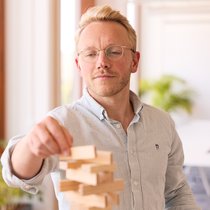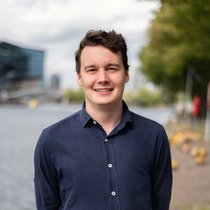The institute serves as a dynamic space for experimentation where scientists, the municipality, investors, businesses, and citizens can test ideas before scaling them across the Amsterdam metropolitan area (and beyond).
Three experts at AMS—a living lab developer, a startup founder, and a researcher—share their experiences on how embracing setbacks transforms the innovation process, creating solutions that truly address Amsterdam's complex urban challenges.
The Value of Controlled Failure
“Today, cities face urgent, complex challenges that cannot be addressed through traditional approaches. These challenges require innovative solutions. You need to experiment, fail, and learn very fast," explains Juanita Devis Clavijo, Urban Living Lab Developer at AMS Institute. "Controlled failure is a great way to collect lessons learned and best practices."
Devis guides Living Lab projects that pilot potential solutions in real-world environments with real users. The approach is inherently iterative: identify challenges, co-create solutions with key stakeholders, implement, test, learn, and adjust. This controlled process allows failure to occur early and on a small scale. "Failing (testing) on a small scale has many benefits. It allows for identifying unintended negative effects, learning about ongoing governance, technical, legal or more in general feasibility challenges. Moreover, it ensures it is an effective solution for the specific challenge and end users are willing to adopt it. This is key if we think about solutions that should be upscaled across the city," she says.
Gaps can surface at pilot projects in all manners: a material’s limitations, technology readiness, policy, business and financial models, or in the case of Amsterdam's Atelier project, all of the above.
“Failing (testing) on a small scale has many benefits. It allows for identifying unintended negative effects, learning about ongoing governance, technical, legal or more in general feasibility challenges.”
Juanita Devis Clavijo
Urban Living Lab Developer
Seeking to advance the green energy transition, the Atelier project piloted Positive Energy Districts (PEDs) in Amsterdam and Bilbao. The goal was to explore how cities can produce, store and share energy locally. This allowed for the identification of opportunities and bottlenecks (failures). The project assumed batteries could easily store and sell surplus energy to the grid, but reality proved more complex.
"Grid congestion, capacity and energy market changes are some of the challenges we (the ATELIER team) encountered in this process," Devis explains. "We learned about energy communities and whether residents have the expertise and are eager to take an active role in it. Our goal is that these lessons will inform key actors on actions they can take to accelerate innovation toward our energy transition goals."
Such insights breed new or different solutions. They are helping cities shape their sustainability strategies, agendas, and initiatives and avoid potentially costly mistakes by ensuring solutions are ready to scale under the right conditions and that citizens are willing to adopt them.
Juanita Devis Clavijo (credits: Vincent Basler)
From Roadblocks to Breakthroughs
For Stef Traa, co-founder of Droppie—which incentivizes recycling through convenient collection points, better communication around recycling, and financial compensation —failure sets the stage.. When Traa and co-founder Natascha Hermsen joined AMS Institute's Startup Booster programme, they assumed major retailers would offer physical space to launch their fun and interactive recycling concept.
"We thought they were going to love us because we would be helping them solve a major packaging waste issue," Traa recalls. But retailers wouldn't allocate even one square meter of valuable store space to the recycling concept.
Yet two robust solutions emerged from this setback. First, lack of retailer participation validated a market for recycling post-consumer waste under one physical roof (Droppie accepts ‘statiegeld’, plastic packaging, textiles, electronics, and more). Second, it prompted rethinking their revenue stream. The growing online vintage clothing market's need for parcel locations accepting all European shipping services would attract customers who could bring recyclables along with their parcels.
"As soon as we got the keys to our first location, potential partners finally understood we were actually going to do this," Traa says. "The EPRs [Extended Producer Responsibility organisations] joined because they saw this as an opportunity they didn’t want to miss."
“We thought they were going to love us because we would be helping them solve a major packaging waste issue.”
Stef Traa

Their first location in Amsterdam West attracted 20,000 visitors in December 2024 alone. And more locations are on the horizon. "We are still learning every day. We have a data analyst and pilot manager conducting weekly experiments on communication and collected materials and we are regularly adding new recycling streams. And it's just the beginning!"
Stef Traa (credits: Vincent Basler)
Failure Accelerates Collective Progress
Titus Venverloo, who leads MIT's Senseable City Lab in Amsterdam, believes the scientific community can often better solve problems wherever the research breaks down, not just when it proves a theory correct.
His role is to connect the city’s challenges to his team of MIT researchers and, in turn, to understand Amsterdam’s priorities and nuances. The team is mapping Amsterdam's tree diversity using laser-based data and satellite imagery to identify green infrastructure not in the city's tree catalogue—about 80% of trees on private property. "If you do such research correctly, you shouldn't know where you're going to end up," Venverloo explains. "A non-significant result is just as reasonable a conclusion."
The team is also developing "Sensing Garden," using computer vision to monitor urban biodiversity by identifying insect species that visit specific plants, which will help to evaluate whether Amsterdam's green policies benefit biodiversity.
The challenge, Venverloo notes, isn't in research outcomes but in how scientists highlight their successes while downplaying limitations—a practice that actually hampers innovation in his view. That’s why in the journal article, his team described the intricacies of monitoring insect species that appear identical, or those that pollinate flowers or benefit apple orchards instead, not to mention how many hundreds of images are needed to train the AI model well enough.
“Researchers want to say, 'My model is 90% accurate,' but what I want to know is where it's inaccurate. What does that 10% look like? If we spent more time describing where things fail and publishing that, we could solve problems faster together.”
Titus Venverloo
Lead, MIT Senseable City Lab Amsterdam & Program Developer
This approach would avoid repeating theories already tried and clarify what problems still matter.
The Innovation Ecosystem
By testing recycling options in real environments, innovative energy solutions in actual neighborhoods, and biodiversity monitoring in Amsterdam's green spaces, the institute generates insights no laboratory could provide.
"That's the magic we do here at AMS," says Devis. "We're learning from failures, creating important lessons and actions. When the municipality or the key actors in our ecosystem learn from these discoveries, they can set up mechanisms to implement those solutions on a larger scale."
As Amsterdam develops its vision for the coming decades, this capacity for structured experimentation—to fail productively in a world of increasingly complex urban challenges—could become its most valuable resource. Through AMS Institute, the city has built an ecosystem that transforms every setback into fuel for the next breakthrough. The question isn't whether the next pilot will succeed—it's what invaluable lesson will emerge when it doesn't go according to plan.

